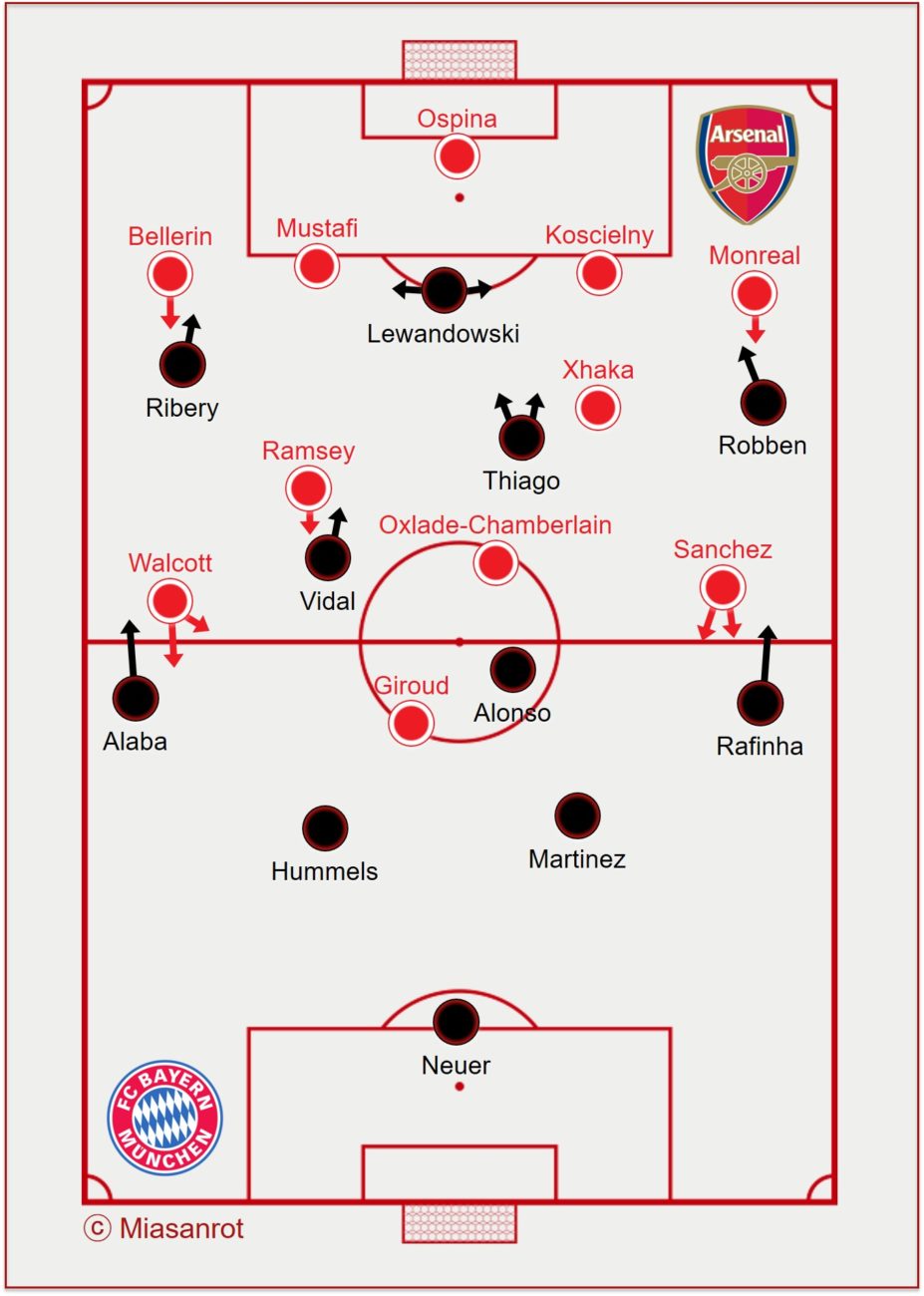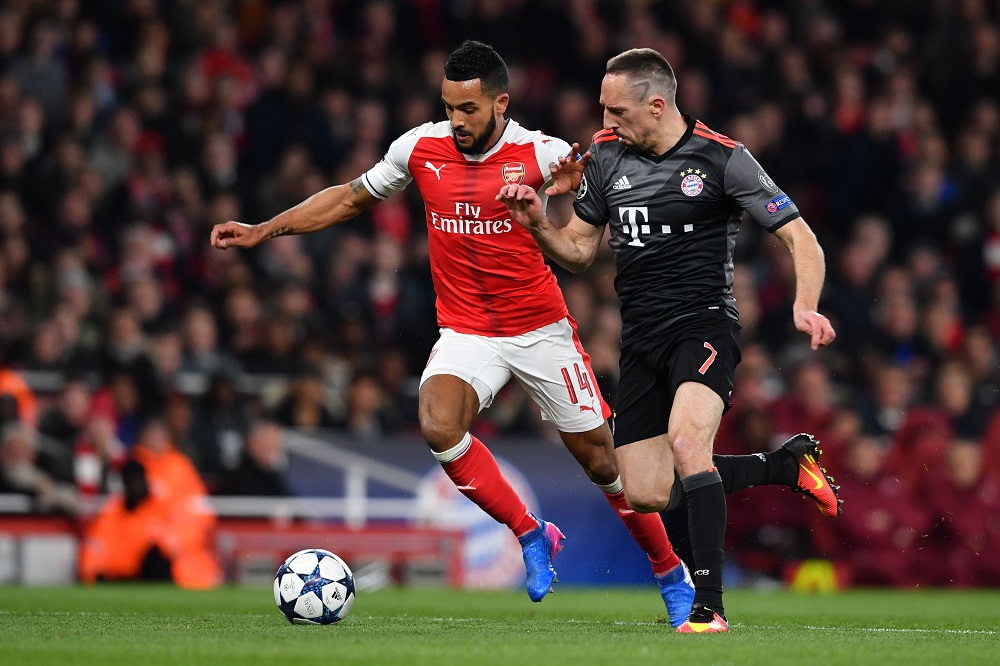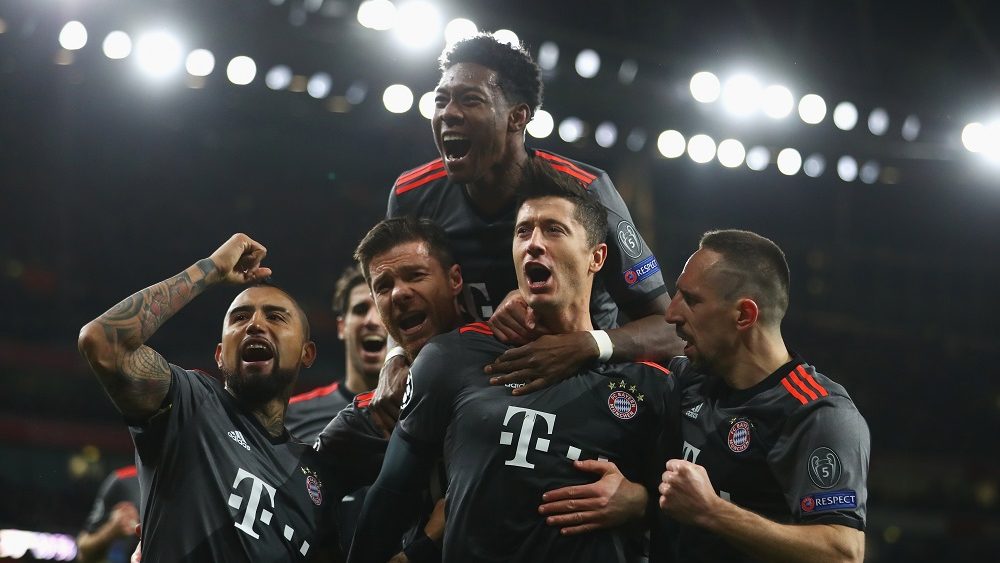3 Things We Noticed: FC Arsenal – FC Bayern 1-5 (1-0)
The last time Bayern was in a similar situation in the Champions League knockout stage, was after their win against FC Barcelona, but that was already in a semi-final. This time Bayern tried to seal their ticket for the quarter-finals.
 Champions League, FC Arsenal v FC Bayern, 07/03/2017, starting formations.
Champions League, FC Arsenal v FC Bayern, 07/03/2017, starting formations.3 things we noticed:
1. Answering the pressure
Hamburg, Schalke, Cologne and also Arsenal in their match in Munich were unable to exploit Bayern’s Achilles heel against well organized, offensive pressing. After Bayern repeatedly struggled against this type of pressing in the first half of the season, Arsenal were able to use Bayern’s limited answers to these problems in their home game.
In the first half Bayern gave away the ball very easily, sometimes due to lacking concentration and sometimes due to a lack of passing options. The build-up play was forced to the wings, where Arsenal was able to attack in superior numbers. Neither Alonso nor Vidal were able to support Martinez or Hummels.
The deeper positioned Thiago could have helped, just like in the Cologne game. Bayern often didn’t even reach Thiago, because of the problems in the first third of the pitch. One indicator for Bayern’s problems in the first half were the six balls won by Oxlade-Chamberlain, who played in the number ten position.
Only 56% ball possession, 7 shots conceded, only 212 passes (only 57 more than Arsenal) and 17 tackles demonstrate Bayern’s problems in the first half.
Alonso does have his strengths, but maybe the combination of Müller as a ten and Thiago as a number six would have been the more appropriate solution against the aggressive pressing by Arsenal. The first half was lost in the centre of the pitch, despite the limited damage due to the clear result from the first leg.
2. Pressing with flaws
Bayern’s pressing reached a higher level in the last games, against Arsenal it looked a bit toothless again. One reason is the mechanism how the wingers cover for each other. Very often neither the full-backs nor the number eights are in a good position to gegenpress after lost balls. The offensive set-up becomes a boomerang in those situations.
Against Arsenal it was Ribery who caused two dangerous Arsenal counter-attacks with lost dribblings. Subsequently Bayern wasn’t able to put their opponents under pressure and the back-four was the last line of defensive to defuse the situation, as they repeatedly did. The interactions between the number eights and the full-backs need to improve in these situations.
Another weak aspect is the missing compactness in Bayern’s play. Vidal and Alonso didn’t push up the pitch, Thiago often was too far up the pitch. Arsenal was able to exploit this space with their pass-happy midfield.
Either the whole team follows the movement of the Spaniard and thus increase the pressure or all players drop back. When one part of the team want one thing and the other part something else, it gets tricky.
This problem was often visible in the first months of Ancelotti’s tenure. Especially the combination of Thiago and Vidal has demonstrated their ability to lead the pressing wave in high zones very efficiently in the last games.
Partnered with Alonso, the Chilean seemed to have less of an impact on the Bayern pressing. Especially when Alsono was the one attacking high up the pitch and not Vidal.
Ancelotti will have a strong influence on the final results with his selection of midfielders in the big games. What conclusions the Italian will draw from the Arsenal game will be seen.

(Photo: Ben Stansall/AFP/Getty Images)
3. A red card and the Bayern switch
As much as one can criticise the first half, Bayern have once again seized the opportunity to fight back and have a strong performance at the right time. The red card for Koscielny also played in their cards.
Just like in the first leg, Arsenal were unable to continue their A game without Koscielny. The Gunners simply aren’t one of the top teams in Europe and in this form also not an appropriate measuring stick for the team of Carlo Ancelotti.
Arsenal were able to have 30 good minutes in the first leg and 45 good minutes in the second leg, where they were able to demonstrate some weak aspects of Bayern’s game, but they are still very far away from being a real title contender in the Champions League.
The game before and after the red card and the subsequent penalty were completely different. That’s why the mentioning of the weaker aspects in Bayern’s game is important.
It’s as important to point at Bayern’s fighting spirit and capability to “hit the switch”. Bayern’s growing reaction after Arsenal’s lead could be felt.
FC Arsenal was close to scoring their second goal, but Bayern was clever enough to defend the big chances. Due to the results from the home game, Bayern only did as much as was needed.
Yes, the red card for Koscielny completely demoralized the Gunners, but Bayern were also able to dictate the tempo and to increase it in the right moments.
Arsenal won’t be the biggest obstacle on Bayern’s Champions League journey this season, but the 10-2 on aggregate is something that could send a message to the European rivals. The self-esteem will help Bayern. The mistakes and flaws in both games nevertheless should not be neglected.
| FC Arsenal – FC Bayern 1-5 (1-0) | |
|---|---|
| FC Arsenal | Ospina – Bellerin, Mustafi, Koscielny, Monreal – Ramsey (72. Coquelin), Xhaka – Walcott, Oxlade-Chamberlain, Sanchez (72. Perez) – Giroud (72. Özil) |
| Bench | Cech – Gibbs, Gabriel |
| FC Bayern | Neuer – Rafinha, Martínez, Hummels, Alaba – Vidal, Alonso – Robben (70. Costa), Thiago (79. Sanches), Ribéry (79. Kimmich) – Lewandowski |
| Bench | Ulreich – Bernat, Müller, Coman |
| Goals | 1-0 Walcott (20.), 1-1 Lewandowki (Elfmeter, 55.), 1-2 Robben (68.), 1-3 Costa (78.), 1-4 Vidal (80.), 1-5 Vidal (85.) |
| Cars | Red: Koscielny (54.) / Yellow: Walcott, Oxlade-Chamberlain, Xhaka / Alaba, Martinez |
| Referee | Anastasios Sidiropoulos (Greece) |
| Attendance | 50,000 (sold-out) |









